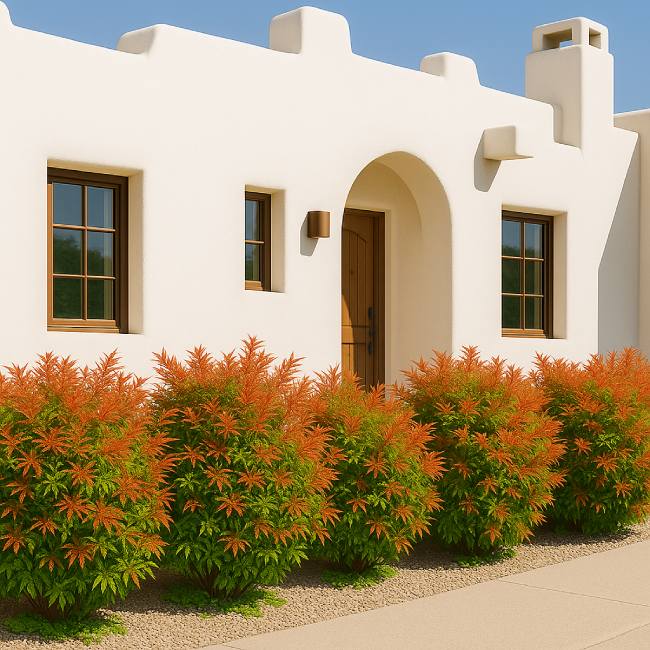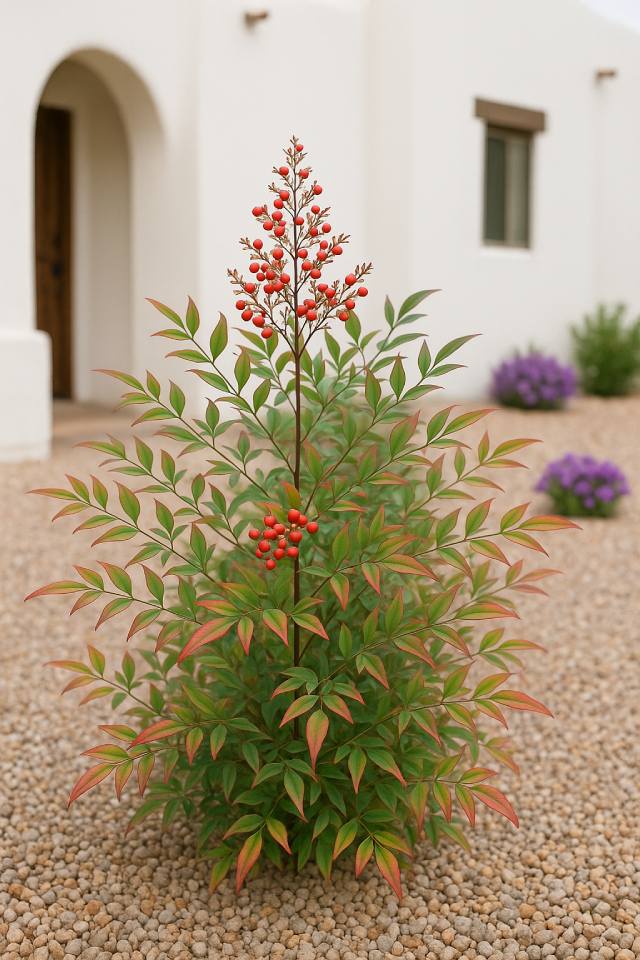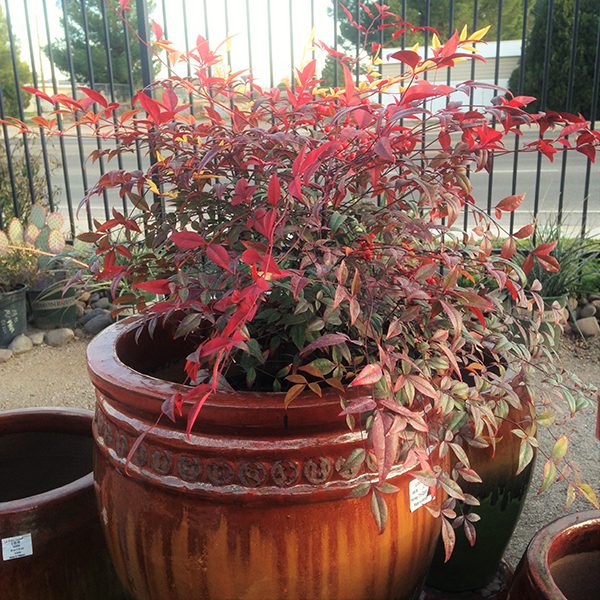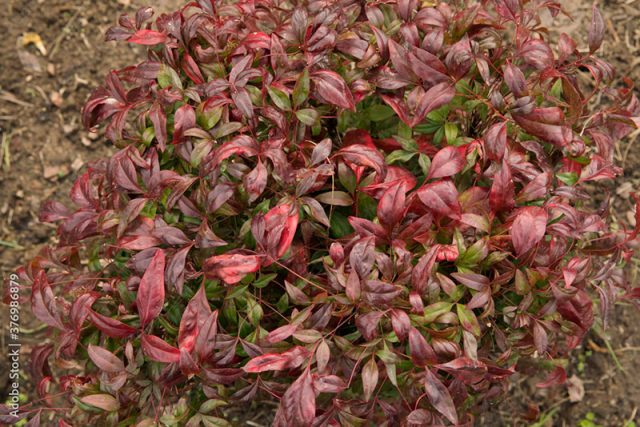Last updated on October 9th, 2025 at 04:26 pm
Heavenly Bamboo Plants for color and landscape design (Nandina Domestica). Also called Nandina, Sacred Bamboo comes in numerous sizes and varieties. It is commonly called Heavenly Bamboo. It is grown for its year-round foliage, green in spring and summer, and, depending on the variety, will turn a red-bronze color in late fall and throughout the winter.
Nandina does well in full sun but can tolerate partial shade. Do not plant in full shade, as they will do ok, but will not turn color in full shade. From my own experience, the more sun they have, the brighter the colors during the fall and winter months. Depending on the variety, they can grow 3′ to 8′ ft. tall and will produce dark red berries that are toxic to humans, pets, and wildlife.
Although these plants require moderate watering, it is advisable to use a good drip system and water 2-3 times per week, basically 5-6 gallons or so.
USDA zones 6-11
The Gulf Stream Nandina
The Gulf Stream Nandina is a smaller bush that grows about 3ft tall and wide.

The Heavenly Bamboo, also known as Gulf Stream Nandina, is a standout shrub that brings vibrant color and texture to your Southwest landscape all year long. In spring and summer, new growth features deep green foliage with soft red highlights that become more pronounced as the plant matures. When cooler weather arrives, the show really begins — the leaves transition into brilliant shades of crimson, copper, and bronze that last well through winter, adding warmth and life to your garden when most plants have gone dormant.
This low-maintenance shrub is drought-tolerant once established and thrives in full sun to partial shade. It’s ideal for foundation plantings, walkways, and accent borders where you want a burst of color without constant upkeep. Pair it with plants like Lantana, Texas Sage, or Red Yucca for a beautiful contrast that complements any Southwest or desert-style home.
How to Control or Manage Nandina
Although Nandina is typically well-behaved in the Southwest’s dry climate, it’s still smart to keep an eye on its growth—especially if you live in areas with occasional summer rains or irrigated landscapes.
1. Prune regularly:
Trim back older stems every year or two to control size and maintain a full, compact shape. Pruning also prevents excessive berry production, which can lead to unwanted seedlings in moist soils.
2. Remove seedlings early:
If young Nandina sprouts appear near the base or nearby beds, pull them out while they’re small. This simple step prevents the plant from spreading into unintended areas.
3. Cut back berries if needed:
In wetter climates or near riparian zones, remove berries before they mature. This helps stop birds from spreading seeds to other parts of your yard or nearby natural areas.
4. Use drought-friendly spacing:
Plant Nandina with adequate space between shrubs and avoid overwatering. This not only saves water—a must in the Southwest—but also limits conditions where Nandina might spread more aggressively.
5. Choose sterile or non-fruiting varieties:
If you want to be extra cautious, select improved cultivars like ‘Gulf Stream’ or ‘Firepower’, which are compact and produce fewer (or no) berries compared to older varieties.
With these easy steps, you can enjoy Nandina’s brilliant red winter color and year-round texture without worrying about invasiveness. It’s a great choice for xeriscape gardens, courtyard landscapes, and foundation plantings throughout New Mexico, Arizona, and West Texas.
The Common Nandina Domestica

I have seen this grow up to 8-9 ft. in and around the Southwest part of the U.S.
The Firepower Nandina
A Cool, Colorful Nandina for Year-Round Beauty
You can use these plants in a rock or Xeriscape landscaping ideas. They do well in containers.
When is the best time to plant these colorful plants? Early fall, you will be rewarded with great color throughout the winter seasons.
Nandinas are slow-growing plants

The Sienna Sunrise, Plum Passion® Heavenly Bamboo, and Tuscan Flame Heavenly Bamboo are also available only at the Monrovia.com website.
Problem with Nandina’s
As mentioned before, berries are toxic to humans and wildlife. It is rare that wildlife will die after eating the berries, including cats and dogs; however, they will make them sick. These plants are favorites for landscapers and homeowners because they are moderate water plants and easy to maintain.
While Nandina can become invasive in regions with heavy rainfall and high humidity, such as parts of the southeastern United States, it rarely poses a problem in the arid and semi-arid climates of the American Southwest. The drier conditions and colder winters in areas like New Mexico, Arizona, and West Texas naturally limit its spread. However, gardeners in east Texas and southern Colorado should remain cautious, as higher moisture levels and milder temperatures can encourage unwanted growth and self-seeding. In most Southwest landscapes, Nandina stays well-behaved and easy to manage, offering its beautiful color and structure without becoming a nuisance.
Aphids can also start eating away at the stems and leaves. It is best to act quickly and spray with neem oil or insecticidal soaps.
The Cucumber and Plantago asiatica mosaic viruses will sometimes affect these plants. You can learn more about these viruses over at Garden Plants Diseases.
Do you have questions about Nandina plants? Please comment on the form below.

Greenhouse Manager, Master Gardener, and Webmaster.
If you have any questions or enjoyed this post, feel free to share your thoughts in the comments below.



